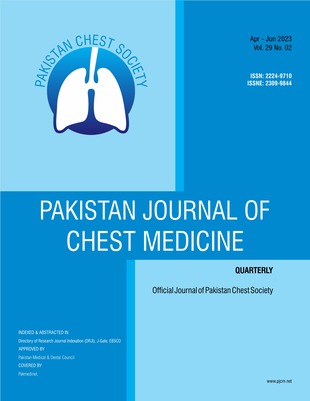Prevalence of Bronchiectasis in Patients Diagnosed with Chronic Obstructive Pulmonary Disease
Keywords:
COPD, Bronchiectasis, PeshawarAbstract
Background: Bronchiectasis is defined as an abnormal dilatation of the bronchi, usually as a result of chronic airway inflammation and/or infection. The prevalence of bronchiectasis in patients with COPD is high and has been recognized as a common comorbidity in COPD patients contributing to severity of symptoms and COPD progression. Early identification and timely intervention will prevent complications and decrease morbidity and the rate of hospital admissions. Objective: The objective of the present study was to determine the frequency of bronchiectasis in patients with diagnosed COPD. Methodology: It was a descriptive, cross-sectional study conducted at the Department of Pulmonology, Khyber Teaching Hospital, Peshawar from 23 June 2019 to 23 Dec 2019. A total of 151 patients diagnosed with COPD (as described in the operational definition) presenting to the Pulmonology Unit at Khyber Teaching Hospital Peshawar were included. Demographic characteristics and associated common risk factors for bronchiectasis like duration of COPD, patient’s age, sex, literacy rate, the severity of COPD, cigarette smoking, indoor air pollution, and BMI were recorded. Each patient underwent CT thorax (HRCT) to assess for the presence of bronchiectasis. Results: In this study, we included 151 patients with a mean age of 55 years. 64.2% were female patients and 35.76% were male patients. Bronchiectasis was present in 41%(64 patients) of the study population. 30.5% were smokers while 69.5% were nonsmokers. 43% of patients had comorbidities ( DM, HTN) while 41% had no comorbidities. 35% of patients had normal BMI while 43% were overweight. Moreover, 86% of our patients were illiterate and 62.9% were housewives. Almost 50% of patients had COPD for more than 10 years. Conclusion: Our study concludes that bronchiectasis was present in 41% of COPD patients. The presence of bronchiectasis is more affected by the duration of COPD, age, gender, literacy rate, and occupation of patients and less affected by the severity of COPD, BMI, comorbidities, or smoking habits of patients. Keywords: COPD; Bronchiectasis; PeshawarReferences
Dou S, Zheng C, Cui L, Xie M, Wang W, Tian H, et al. High prevalence of bronchiectasis in emphysema-predominant COPD patients. Int J Chron Obstruct Pulmon Dis. 2018;13:2041.
Global Initiative for Chronic Obstructive Lung Disease. GOLD Report. 2018.
da Silva SM, Paschoal IA, De Capitani EM, Moreira MM, Palhares LC, Pereira MC. COPD phenotypes on computed tomography and its correlation with selected lung function variables in severe patients. Int J Chron Obstruct Pulmon Dis. 2016;11:503–513,
Elahi NM, Ali S, Chaudhary MA, Dar UF, Riaz MS, Majid M. Frequency and Patterns of Bronchiectasis in Patients with Chronic Obstructive Pulmonary Disease. Pak J Med Health Sci. 2015;9(1):410-2.
Martinez-Garcia MA, Miravitlles M. Bronchiectasis in COPD patients: more than a comorbidity?. Int J Chron Obstruct Pulmon Dis. 2017;12:1401
Ni Y, Shi G, Yu Y, Hao J, Chen T, Song H. Clinical characteristics of patients with chronic obstructive pulmonary disease with comorbid bronchiectasis: a systematic review and meta-analysis. Int J Chron Obstruct Pulmon Dis. 2015;10:1465–1475
Bafadhel M, Umar I, Gupta S, Raj JV, Vara DD, Entwisle JJ, Pavord ID, Brightling CE, Siddiqui S. The role of CT scanning in multidimensional phenotyping of COPD. Chest. 2011;140(3):634-42.
Arram EO, Elrakhawy MM. Bronchiectasis in COPD patients. Egypt J Chest Dis Tuberc. 2012;61(4):307-12.
Gatheral T, Kumar N, Sansom B, Lai D, Nair A, Vlahos I, Baker EH. COPD-related bronchiectasis; independent impact on disease course and outcomes. COPD J. 2014;11(6):605-14.
Agusti A, Calverley PM, Celli B, Coxson HO, Edwards LD, Lomas DA, et al. Evaluation of COPD Longitudinally to Identify Predictive Surrogate Endpoints (ECLIPSE) Investigators Characterisation of COPD heterogeneity in the ECLIPSE cohort. Respir Res. 2010;11(1):122.
Polverino E, Dimakou K, Hurst J, Martinez-Garcia MA, Miravitlles M, Paggiaro P, et al. The overlap between bronchiectasis and chronic airway diseases: state of the art and future directions. Eur Respir J. 2018;52(3).
Du Q, Jin J, Liu X, Sun Y. Bronchiectasis as a comorbidity of chronic obstructive pulmonary disease: a systematic review and meta-analysis. PloS one. 2016;11(3):e0150532.)
Elahi NM, Ali S, Chaudhary MA, Dar UF, Riaz MS, Majid M. Frequency and Patterns of Bronchiectasis in Patients with Chronic Obstructive Pulmonary Disease. Pak J Med Health Sci. 2015;9(1):410-2.
da Silva SM, Paschoal IA, De Capitani EM, Moreira MM, Palhares LC, Pereira MC. COPD phenotypes on computed tomography and its correlation with selected lung function variables in severe patients. Int J Chron Obstruct Pulmon Dis.2016;11:503-13.
Downloads
Published
How to Cite
Issue
Section
License
Copyright (c) 2023 Pakistan Journal of Chest Medicine

This work is licensed under a Creative Commons Attribution-NonCommercial 4.0 International License.








